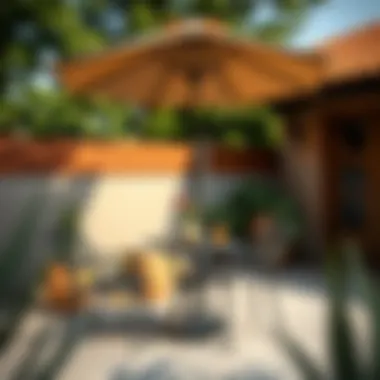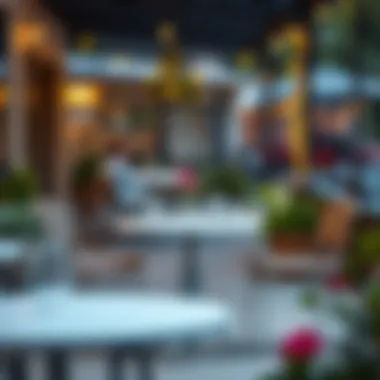Small Bistro Tables: Merging Functionality and Style


Intro
Small bistro tables with umbrellas offer a unique blend of charm and practicality that can transform any outdoor nook. These tables are perfect for sipping coffee in the morning sun or enjoying a leisurely meal in the shade on a hot day. With their chic designs and functional features, they can elevate the aesthetics of patios, balconies, or gardens. Let's venture into the intricate aspects of choosing and arranging these pieces of furniture in a way that harmonizes form and function.
Furniture Styles and Trends
Exploring Popular Furniture Styles
The world of outdoor furniture is brimming with options, and bistro tables are no exception. You have the classic Parisian style—an embodiment of casual elegance with its round, often metal tables, typically paired with brightly colored woven chairs. This type is not just a table; it brings a piece of European café culture to your home.
But, if you're aiming for a more modern fit, consider tables made from sleek stainless steel or minimalistic designs with clean lines. These styles often feature tempered glass tops that add a contemporary flair while being easy to clean.
- Rustic Charm: Think weathered wood and earthy tones. A bistro table in this style pairs beautifully with plants and enhances the organic feel of the outdoors.
- Industrial Touch: If the urban aesthetic appeals to you, industrial-style tables with metal frames and reclaimed wood tops can create a bold statement.
Understanding Current Design Trends
Trends come and go, but certain features are making waves in bistro table design today. Sustainability is top of mind for many homeowners. Thus, many are exploring tables made from recycled materials or those sourced from sustainable forests. Furthermore, functionality is a vital component—look for tables where the umbrella can easily tilt or extend, offering shade just when you need it.
Look out for geometric shapes and unique silhouettes that stray from traditional norms. For instance, hexagonal or asymmetric designs can add an eye-catching element to your patio, steering away from the standard round or square tables.
"Choosing outdoor furniture isn't just about aesthetics; it's about creating a space that feels like an extension of your home."
Practical Tips for Furniture Selection
Factors to Consider When Choosing Furniture
Selecting the right bistro table isn’t solely about picking a nice design. Several factors contribute to an informed decision:
- Material: Consider factors such as durability and maintenance. Metal tables might require rust-resistant coatings, while wooden tables may need regular sealing to withstand the elements.
- Size: Scale is crucial. Choose a table that fits your space without overwhelming it. A large table in a small area can stifle movement, while a tiny table may look lost in a vast outdoor setting.
- Color and Finish: Think about how the color will harmonize with your existing outdoor decor. Dark colors can absorb heat, while lighter shades may complement floral arrangements or outdoor cushions.
How to Measure and Optimize Space
Before you hit the shops, measure your space to avoid buyer's remorse. Take note of the area you want to furnish, considering:
- Table Dimensions: Ensure the height of the table allows comfortable seating without causing neck strain.
- Clearance: Leave a good amount of space around the table for people to move comfortably. A minimum of two feet around the table is ideal.
- Usage: Think about how you intend to use the table. If you plan to dine at it regularly, you might want a larger size compared to a table mainly for drinks.
By considering these factors, you can create a cohesive outdoor area that welcomes gatherings and moments of solitude alike.
Preamble to Small Bistro Tables with Umbrellas
In today’s fast-paced world, creating welcoming outdoor spaces has become more than a mere luxury; it’s a necessity for many homeowners. Small bistro tables with umbrellas stand at the intersection of functionality and aesthetics, providing an inviting spot for relaxation or social gatherings. These tables not only enhance the beauty of outdoor settings but also offer practical solutions against the elements.
Consider a quaint garden, where a small bistro table serves not just as a piece of furniture, but as a connector of experiences. Perhaps it hosts morning coffee rituals, evening chats, or casual meals under the shade. It takes a certain flair to choose the right table that embodies both style and utility—therein lies the importance of understanding these versatile furniture items.
When delving into the world of small bistro tables and umbrellas, think about how they can change a bland patio into a vibrant social hub. The right table can make a small area feel intimate, while an umbrella adds an essential layer of comfort against the harsh sun. Imagine, on a sweltering summer day, retreating to your charming little table, where the shade provides a lovely respite.
Additionally, when selecting these tables, one must consider various elements:
- Style: From classic to modern, the design choices are plentiful, allowing for personalization in outdoor settings.
- Functionality: These tables are perfect for smaller spaces, as they can be compact yet functional, fitting just about anywhere.
- Durability: Understanding the materials involved can make a significant difference in longevity and maintenance.
As we explore further into this article, we will outline the essential considerations around small bistro tables with umbrellas, diving into their materials, design variations, and practical uses. Each section will build upon the previous one, illustrating the myriad ways these tables can serve not just as furniture, but as an integral part of outdoor living spaces.
"The beauty of small bistro tables lies in their ability to transform any space into a delightful oasis, perfect for both relaxation and social connection."
Through this journey, we aim to equip readers with knowledge that aligns with their unique style preferences while also being informed of the practical aspects essential for outdoor enjoyment.
Understanding the Basics
When it comes to outdoor furnishing, the heart of the matter is often what lies at the core of the setup: small bistro tables with umbrellas. To many, these elements might seem trivial, yet they play a significant role in transforming a mere backyard or balcony into an inviting refuge. Understanding the basics provides insight into their functionality, aesthetic contributions, and a deeper appreciation of their essential role in outdoor discourse.
Definition and Purpose
Small bistro tables are typically compact, often round, tables that serve as a perfect spot for outdoor meals or casual gatherings.
- These tables not only conserve space, enabling homeowners to utilize tighter areas effectively, but they also bring elements of charm and character that may be sorely lacking in larger setups.
- The purpose of integrating umbrellas into the design is twofold. They serve to provide shade on scorching summer days, allowing diners to relish their meals without the glaring sun ruining the experience. Furthermore, they add a visual flair that enhances the overall aesthetics of the space.
Essentially, when one speaks of these tables, it’s not just about functionality. It’s about creating a cozy corner to sip morning coffee, perhaps while watching the sunrise, or sharing laughter with friends over evening cocktails under a starlit sky. In every instance, it forms a gathering point and sets the stage for memorable moments.
Historical Context
To appreciate the impact of small bistro tables and their umbrellas, it's essential to trace their roots back to the quaint cafes of 19th-century Paris, where they first began to make their mark. These charming little tables were not just functional; they were a cultural phenomenon.
- Imagine Parisian streets adorned with tables that brought people together, all the while enjoying the aroma of freshly brewed coffee. Back then, it was about connection—gathering with loved ones to enjoy simple pleasures.
- Over the years, these tables evolved, influenced by various styles and materials as they spread across Europe and beyond, fitting into diverse settings and cultures.
In modern design, their appeal has continued unabated, where they bridge historical charm and contemporary ease. A well-placed bistro table can evoke nostalgia while meeting the demands of modern outdoor living, merging style with practicality seamlessly. > "Simplicity and charm unite in bistro tables, where history shapes our gathering spaces today."
Understanding this context sets the foundation for recognizing their importance in today’s outdoor furniture market. With climate considerations and a growing concentration on curated outdoor aesthetics, these bistro tables continue to be a staple item that reflects not just function but also a personalized touch to outdoor spaces. Their significance thus extends beyond mere furniture; they are an embodiment of culture and lifestyle.
Material Considerations
When it comes to small bistro tables with umbrellas, the choice of materials isn’t just a matter of preference; it shapes the longevity, aesthetic appeal, and functionality of the furnishings. Different materials offer various benefits and drawbacks in terms of style, maintenance, and usability in outdoor settings. Understanding these material options can greatly enhance your outdoor experience, ensuring that your investment aligns with your taste and needs.
Common Materials Used
Wood
Wooden bistro tables often evoke a sense of warmth and charm that many homeowners find inviting. One specific aspect that wood brings to the table—quite literally—is its natural look. This keeps your outdoor setup in harmony with the environment. Teak, cedar, and eucalyptus are popular choices, each with their own unique character.
A key characteristic of wood is its ability to develop a beautiful patina over time, giving it a personality that manufactured materials often lack. Its versatile nature allows numerous styles from rustic to contemporary. However, wooden tables may require regular maintenance such as sealing or staining to protect against elemental wear. This drawback can be a hassle for some—but for many, the aesthetic beauty is worth the extra effort.
Metal


Metal bistro tables are known for their sturdiness and sleek lines. Whether you opt for aluminum, steel, or wrought iron, these tables usually resist the wear and tear of outdoor exposure. One unique feature of metal is its ability to be powder-coated, which offers a protective layer and adds an array of color options. This broad color palette allows homeowners to express their personal style without compromising durability.
However, it’s worth noting that metal can heat up quickly in sunlight, potentially becoming uncomfortable to touch. Also, it may require occasional rust treatment, especially for lower-quality variants exposed to moisture.
Plastic
Plastic tables are often favored for their lightness and affordability. They can be easily moved around, making them a great option for those who frequently rearrange their outdoor spaces. Polypropylene and polyresin are common materials used for their weather-resistant properties.
While plastic tables can mimic the appearance of wood or metal, a common critique is their lack of sophistication. They’re often viewed as less durable, especially if not chosen wisely. However, they can be a practical choice for casual dining or spaces where style is secondary to function.
Glass
Glass bistro tables are striking and can lend an air of sophistication to any outdoor area. Their transparency gives them a lightweight feel even when the structure is solid. A common aspect of glass tables is their ability to reflect surrounding beauty, blending into any settings seamlessly.
That said, glass tables usually carry some concerns. They can be susceptible to chips or cracks, depending on the quality of the glass used. Furthermore, leveling and cleaning can be a minor hassle compared to other materials. Still, the sheer elegance they offer can elevate your outdoor dining experience.
Durability and Maintenance
Durability plays an essential role in any outdoor furniture consideration. Each material reacts differently to weather elements, either enhancing or detracting from the table's lifespan. Understanding maintenance requirements can save you headaches down the road.
- Wood tables need sealing and regular treatments.
- Metal options may require rust-proofing but generally stand the test of time.
- Plastic is low-maintenance but might not stand for long periods under heavy use.
- Glass can need a comforting touch to keep it shining but always catches the eye.
Balancing aesthetics and lasting value is key, and knowing the ins and outs of your options can ensure your bistro table with an umbrella remains a delightful focal point in your outdoor living space.
Design Variations
Design variations play a significant role in shaping the attractiveness and functionality of small bistro tables with umbrellas. These tables not only provide a place to enjoy meals or drinks outdoors, but their design influences the entire ambiance of an outdoor space. By examining various styles, homeowners can find a table that complements their unique taste while addressing practical considerations. From classic elegance to modern simplicity, the choice of design can enhance any outdoor setting and can even influence the table's suitability for different environments.
Styles and Aesthetics
Classic
Classic style bistro tables often evoke feelings of nostalgia and charm, making them a popular choice for those looking to create a timeless outdoor setting. Characterized by ornate details, contoured edges, and often a wrought iron base paired with a wood top, these pieces effortlessly mesh with traditional decor. One significant characteristic of classic tables is their robust silhouettes, which exude a feeling of solidity and permanence.
Incorporating a classic bistro table into your outdoor space can create a warm, inviting atmosphere, perfect for family gatherings or casual dining. However, it's also essential to consider that these tables may require more upkeep than their modern counterparts, particularly when it comes to weather resistance.
Modern
The modern design approach brings simplicity and sleekness to bistro tables, focusing on clean lines and minimalistic aesthetics. A key characteristic of modern styles is the use of materials like stainless steel, aluminum, or even high-quality molded plastic, which not only achieve a contemporary look but also enhance durability.
These tables often feature a neutral color palette, allowing them to fit seamlessly into a variety of outdoor settings. The unique feature here is their low maintenance, as many modern designs are built to withstand the elements without much fuss. This makes them an excellent choice for busy homeowners or anyone looking to keep their outdoor space streamlined and stylish.
Minimalist
For those who value understatement, minimalist bistro tables present an appealing option. They focus on functionality without sacrificing elegance, offering simple designs that serve as the perfect backdrop for outdoor dining. The hallmark of minimalist tables is their simplicity, often made with materials such as light metals or wood with a straightforward finish.
This style enables a clean canvas, making it easy to mix and match with various decorations or events. However, it's crucial to note that while aesthetically pleasing, some minimalist designs can lack the comfort and warmth of more elaborately designed tables.
Rustic
Rustic bistro tables are all about embracing the beauty of the natural world. Typically constructed from reclaimed wood or wrought iron, they showcase imperfections that add character. The charm of rustic designs lies in their authenticity and the way they tie in with nature. A key characteristic is often the warm tones, which invite relaxation and warmth to any gathering.
This style works well in gardens or patios that emphasize organic textures. While they can add tremendous personality to a space, the maintenance can sometimes be more demanding, with wood treatments overriding the effort invested in creating that charming, weathered look.
Customization Options
In today's market, customization opens up a new world of possibilities for small bistro tables. Homeowners can select colors, materials, and even adjust the size to ensure the furniture fits perfectly into their desired spot. Choosing custom options can significantly enhance the longevity and personal touch of outdoor spaces, allowing for a scene that’s not just functional but reflective of individual style. Whether going for an eye-catching finish or subtle hues, customization if often a game changer in choosing the right bistro table.
Selecting the Right Size
Selecting the right size for small bistro tables with umbrellas is an essential aspect that can tremendously impact both functionality and overall aesthetic appeal in outdoor spaces. Size matters not just for practical use but also harmonization within a given area. A well-chosen table can elevate a small nook into a cozy dining experience or create a vibrant gathering spot for friends and family. On the other hand, an ill-suited dimension can make a space feel cramped or sparse.
Before diving into specifics, consider the overall dimensions of the outdoor area where the bistro table will reside. Visibility, accessibility, and even movement should be evaluated. Cramped spaces might necessitate opting for smaller, lighter tables that can be easily moved, while more spacious decks or patios could accommodate larger models that offer more seating and elegance.
Space Requirements
When considering space requirements for bistro tables, the first step is to measure the available area. Think about not just the table itself, but also the surrounding room necessary for chairs and any additional elements like an umbrella. A common rule of thumb is to leave about 36 inches of clear space around the table. This allows for comfortable movement as well as the ability for diners to relax without feeling cramped.
Here’s a quick breakdown of factors to consider:
- Total area available: Measure the length and width of the outdoor space, where the table will be located, including any obstructions like garden beds or railings.
- Table size vs. guest needs: Determine how many people you frequently entertain. For two people, a small table of about 24-30 inches in diameter works well, while a three-to-four-person capacity may require tables in the range of 36-48 inches.
- Umbrella height and width: When choosing a table with an umbrella, remember that the umbrella should not only fit the table but also account for the wind and height of the items below, such as seating.
Proportions in Design
Proportions play a significant role in the overall aesthetics and functionality of small bistro tables. The relationship between the size of the table and its chairs, as well as the surrounding elements, can either create a balanced look or result in a chaotic environment.
To achieve pleasing proportions:
- Ratio considerations: A general guideline is selecting chairs that are about 10-12 inches lower than the tabletop. This ensures comfort and elegance while maintaining a cohesive look.
- Visual weight: Consider how the bistro table complements other furniture in the outdoor area. For example, a sleek, minimalist table may pair best with similarly styled chairs to avoid a visual clash. On the other hand, a bold, heavy table might require lightweight, airy chairs to balance the aesthetic.
- Effect of colors and materials: The materials used for the table and chairs can significantly influence the perception of size. Dark, heavy materials can feel bulkier, while light colors and transparent materials lend an airy feel.
"The right size is not just about fitting in, it’s about flowing seamlessly within your space—creating harmony that invites you to linger."
In summary, taking the time to measure, evaluate, and contemplate the space requirements and proportions will undoubtedly lead to a more enjoyable outdoor experience. Choosing the right size not only enhances the utility of the space but also ensures that it reflects personal style and preference.
Functionality and Practical Use Cases
When it comes to small bistro tables with umbrellas, the focus on functionality and practical use cases cannot be overstated. These tables are not just simple pieces of furniture; they serve a myriad of purposes that contribute to both the utility and enjoyment of outdoor spaces. This section will break down how these tables can enhance everyday experiences, from casual meals to vibrant social gatherings.
Outdoor Dining
Outdoor dining transforms mundane meal times into delightful experiences. Picture a lazy Sunday brunch with friends or a romantic dinner under the stars. Small bistro tables offer a cozy seating arrangement while the umbrellas provide much-needed shade during scorching summer days or protection from unexpected drizzles.


Several points illustrate the appeal of outdoor dining with these tables:
- Space Efficiency: Small bistro tables are perfect for patios, balconies, and gardens where space is at a premium. They allow for a comfortable dining area without overwhelming the available space.
- Versatility: They can accommodate various group sizes, from an intimate two-person setting to a larger gathering with multiple tables pushed together. You can mix and match depending on your needs.
- Health Benefits: Eating outdoors can boost mood and appetite, making meals feel more relaxed and enjoyable. Fresh air and natural light are good for everyone, especially during those beautiful spring and summer days.
"Small spaces don't mean you have to sacrifice comfort or style. A well-placed bistro table can create an inviting nook for outdoor dining."
Selecting the right type of umbrella also enhances the dining experience. For example, a market umbrella can provide stylish coverage, keeping the food fresh while avoiding sunburns. Exploring different types of tables and an appropriate umbrella is key to maximizing this setup.
Social Spaces
In addition to dining, small bistro tables play a significant role in creating social spaces. They become the centerpiece of gatherings, encouraging conversation, laughter, and connection. The informal setting of a small table can make it easier for people to engage.
Consider the following aspects of using these tables for social purposes:
- Instilling a Sense of Community: Whether it's a garden party, a book club meeting, or just catching up with neighbors over coffee, small bistro tables help kindle a feeling of togetherness. The layout invites interaction rather than isolation, fostering dialogue and camaraderie.
- Functional Decor: The aesthetic elements of the tables enhance the overall look of outdoor areas. Choosing vibrant colors for tables and umbrellas can instantly elevate the surroundings, making them more appealing to physical and virtual guests alike.
- Easy Cleanup and Setup: These tables are generally lightweight and easy to move, making setup and breakdown for gatherings a breeze. This practical aspect lets you adapt your social space on a whim.
From outdoor dining to social interactions, small bistro tables with their accompanying umbrellas strike a balance between form and function. They are versatile assets that facilitate numerous experiences, turning an average outdoor area into a vibrant living space.
The Role of Umbrellas in Design
In the context of small bistro tables, umbrellas are not merely an afterthought; they serve as vital elements that harmonize functionality with style. An umbrella can transform a simple outdoor table into a delightful retreat, providing much-needed shade during those sizzling summer days and creating a cozy ambiance for evening gatherings. The interplay of the umbrella's design with the bistro table can either complement or distract from the overall décor, making the selection process crucial.
An umbrella can evoke a sense of style and personality, enhancing the outdoor space. When properly integrated, it can become the centerpiece of your setting, drawing attention without overwhelming the other elements present. Thus, understanding the types of umbrellas available and their unique features becomes paramount for homeowners and decorators alike.
Types of Umbrellas
Market Umbrellas
Market umbrellas stand out due to their classic look and sturdy construction. Typically larger than others, they offer ample coverage, making them a practical choice for more extensive outdoor dining settings. Their key characteristic is the ability to pivot, offering flexibility in adjusting shade angle based on the sun's position.
Furthermore, they often come in various fabric colors and patterns, allowing personalization. In practical terms, when placed over a small bistro table, a market umbrella can create a distinct visual impact while providing shade for multiple seats. This adaptability makes them a popular choice for those looking to marry style with practicality.
However, one must consider that market umbrellas might require more substantial bases due to their height and width. This can take up additional space and may require a more robust table to support it effectively.
Patio Umbrellas
Patio umbrellas are commonly used in residential settings, and for good reason. Their widespread popularity comes from a design that accommodates the various styles of outdoor furniture. Generally, they feature a central pole with a fabric canopy, allowing for a decent amount of shade without obstructing views too much.
What sets patio umbrellas apart is their portability. Many models are lightweight and can be easily repositioned as needed, adapting to the movement of the sun throughout the day. Homeowners looking for versatility may find patio umbrellas a beneficial addition to their outdoor space, particularly in smaller areas where footprint matters.
On the downside, their structural integrity may not match that of market umbrellas or cantilever models, especially in windy environments, which could necessitate more careful placement and potentially securing measures.
Cantilever Umbrellas
Cantilever umbrellas offer a unique twist to outdoor shade solutions. Instead of a pole centered within the table, they rely on a side-positioned pole with a curved arm, extending the canopy over the table without obstruction. This innovative design allows for maximum space utilization, keeping the area beneath the table open and free of clutter.
The key characteristic of cantilever umbrellas is their ability to shade larger areas without requiring a large base under the table itself, making them particularly suitable for small bistro settings. They often sustain heavier winds better than traditional umbrellas, providing stability in varying conditions.
Nevertheless, cantilever umbrellas can be more expensive and require careful installation. This could deter some buyers, yet those who prioritize aesthetics alongside functionality often deem them worth the investment.
Benefits of Adding an Umbrella
The advantages of incorporating an umbrella into your bistro table setup go beyond mere aesthetics.
An umbrella not only enhances outdoor comfort but also protects furniture from weather elements, prolonging its life.
By offering shade, bistro tables become inviting spots for dining, relaxation, and socializing, making outdoor spaces more functional. Importantly, umbrellas can also help define the area, creating designated zones within a larger outdoor setting. This is particularly beneficial for homeowners looking to craft a distinct look without overwhelming the space with additional furniture options.
In summary, the role of umbrellas in design is multifaceted; they weave functionality and aesthetics together, enabling outdoor areas to flourish in both form and practicality.
Color and Theme Coordination
Color and theme coordination plays a pivotal role in the overall aesthetic of small bistro tables with umbrellas. When trying to create an inviting outdoor area, the choice of colors and themes can dramatically affect the atmosphere and functionality of the space. Achieving a cohesive look not only adds to the beauty of the furniture itself but also enhances the overall gardening or patio style, making it more visually appealing.
One of the benefits of thoughtfully coordinating colors is that it allows homeowners to express their personality through their outdoor spaces. Depending on personal preferences, themes may range from sleek modern options with monochromatic tones to vibrant Mediterranean colors that call to mind sun-drenched vacations. This consideration can harmonize any setting, creating a relaxing oasis amid the hustle and bustle of everyday life.
Moreover, color choices can be significant in reflecting seasonal moods and experiences. Whether you prefer earthy greens and browns for a rustic look or lively yellows and reds to invoke a cheerful vibe, the color scheme can profoundly impact how one experiences the space. Achieving a well-finished, well-coordinated look can draw people in, encouraging them to linger, share meals, or just enjoy the scenery.
Establishing a Cohesive Look
Establishing a cohesive look often begins with selecting a primary color palette. This central theme can unify various elements, from bistro tables and umbrellas to planters and outdoor cushions. A strong color palette not only streamlines choices but also simplifies decoration efforts. For instance, if a homeowner selects a navy blue and white combination, finding cushions, tableware, and decorative accessories in those colors becomes a more straightforward process.
"A well-thought-out color scheme can harmonize your outdoor vibe and create a warm, inviting atmosphere."
Next, consider the finish and texture of materials. A matte finish may evoke a more modern aesthetic, while glossy finishes can feel more elegant. Currently, many people gravitate toward natural finishes, like wicker or wood, that integrate seamlessly with a garden backdrop. This interplay of colors and textures not only amplifies aesthetic appeal but also fosters a welcoming environment that resonates with guests.
Seasonal Considerations
Different seasons can inspire remarkable shifts in how people design their bistro space. In spring and summer, lighter, brighter colors tend to dominate. Soft pastels and vibrant hues mirror the blooming flowers and sunny weather—think lemon yellow umbrellas or aqua tables set against colorful floral arrangements.
Come fall, richer tones engage the senses. Deep reds, burnt oranges, and rustic browns resonate with the earthy tones of autumn foliage. This shift can include changing the bistro table’s accessories: switching to heavier fabrics or warmer colors for cushions while maintaining the table’s core style.
During winter, many opt to use the space less frequently, but that doesn’t mean the coordination has to cease. Incorporating elements like greenery—real or artificial—and warm lighting through lanterns brings a cozy, intimate feel even during the colder months. Such attentiveness to seasonal color and theme can create a living outdoor area that ebbs and flows with the changing year.
Sustainability in Outdoor Furniture
Sustainability in outdoor furniture has become more than just a buzzword; it's a focal point for conscientious consumers aiming to make informed decisions about their outdoor spaces. As homeowners and design enthusiasts seek to create functional yet aesthetically pleasing environments, the impact of their choices on the planet cannot be overlooked. The increasing awareness around the environmental footprint of materials and manufacturing practices compels us to think critically about what we bring into our homes and gardens.
The pivotal aspect of sustainability lies in the thoughtful selection of eco-friendly materials and responsible manufacturing practices. This dual approach not only helps preserve the environment but also contributes to a healthier outdoor living experience. Below, we explore how these elements come into play when considering small bistro tables with umbrellas.
Eco-friendly Materials


When choosing small bistro tables, opting for eco-friendly materials can lead to a significant reduction in environmental impact. In contrast to traditional materials, sustainable options often involve renewable resources or recycled content, thereby minimizing the carbon footprint.
Some popular sustainable materials include:
- Reclaimed Wood: Using wood salvaged from old structures reduces waste and gives a rustic charm to outdoor furniture. It tells a story and adds character to your space.
- Bamboo: Known for its rapid growth and strength, bamboo is a renewable resource that makes for an excellent alternative to hardwoods. It’s light, durable, and often treated to withstand weather elements.
- Recycled Aluminum: This lightweight metal is not only rust-resistant but when recycled, it saves energy and natural resources compared to primary aluminum production.
- Synthetic Fabrics: Fabrics made from recycled plastics can be both stylish and durable. They can withstand the elements and are often designed to be easy to clean and maintain.
By incorporating these materials into their designs, manufacturers not only support the environment but also appeal to a growing market of consumers who are increasingly looking for greener options.
Responsible Manufacturing Practices
Beyond the materials themselves, responsible manufacturing practices play a crucial role in creating sustainable furniture. It's not just about what a product is made from, but how it’s made. The following aspects are essential when considering the sustainability of any piece of outdoor furniture:
- Ethical Labor Practices: Ensuring that workers are treated fairly and work in safe conditions is integral to the sustainability story. Brands that emphasize ethical treatment of laborers contribute to a more responsible industry overall.
- Local Sourcing: By sourcing materials locally, companies can reduce transportation emissions and support local economies. This often results in fresher materials and a smaller carbon footprint.
- Energy-efficient Manufacturing: Utilizing energy-efficient processes can significantly lower the environmental impact of producing furniture. Companies that invest in renewable energy or green technology often achieve better sustainability ratings.
- Waste Reduction Strategies: Implementing strategies to minimize waste during production is another critical step. This may involve recycling and repurposing scrap materials or using production methods that generate less waste.
"Sustainability is not just a goal; it’s a way of life. Choosing the right materials and practices integrates beauty with responsibility in your outdoor spaces."
In sum, the intersection of eco-friendly materials and responsible manufacturing practices presents an opportunity to enrich your outdoor experience while caring for the environment. Adopting sustainable practices not only aligns with today’s values but also encourages a mindful approach to furnishing, where every choice enhances both living spaces and the planet.
Cost Considerations
When one contemplates the purchase of small bistro tables with umbrellas, analyzing the cost is not just a matter of checking price tags. It's a multilayered evaluation that encompasses immediate expenses, long-term sustainability, and the overall value these items can provide to an outdoor space. Cost considerations influence not just purchasing decisions but can also shape the aesthetic and functional landscape of your outdoor dining experience. Discerning homeowners and design enthusiasts need to weigh various elements to ensure they garner optimal quality without overshooting their budgets.
Budgeting for Quality
When it comes to furniture, the old adage "you get what you pay for" often rings true, and small bistro tables are no exception. Understanding how to budget effectively can save a penny or two while ensuring that the materials and craftsmanship stand the test of time. Think about a solid teak table priced a shade higher than a comparable plastic model. Teak offers durability and natural resistance to the elements. This means fewer repairs and replacements down the line, translating to savings.
- Prioritize Materials: Investing in quality materials like wrought iron or high-grade steel increases longevity and reduces maintenance costs.
- Assess Your Usage Needs: If you're planning to host summer barbecues and family gatherings, it may pay to buy a sturdier set that can withstand heavy use.
Budgeting means planning for your outdoor lifestyle. It's about asking whether you want一or need—a beautiful piece of furniture for the occasional coffee in the garden or a robust table for lively gatherings.
Long-term Investment Values
Choosing to invest in good-quality small bistro tables with umbrellas can yield significant dividends over time. Not only do these tables enhance your outdoor living space, but they also often add to your property value.
Consider this: A well-crafted bistro set can transform your patio into an inviting retreat. On the flip side, cheap furniture tends to deteriorate quickly, leaving your outdoor area looking lackluster and underwhelming. Moreover, long-lasting furniture can save you the trouble of continuous replacements.
A few points to ponder regarding long-term values:
- Property Enhancement: Quality outdoor furniture has a way of making your living space more appealing. Buyers often eye well-furnished outdoor areas more favorably.
- Maintenance Costs: Investing upfront in materials can significantly diminish ongoing expenses associated with repairs and upkeep.
In essence, treating your bistro tables as a long-term investment rather than a quick purchase can reshape your budgeting for outdoor spaces. As you plan, keep in mind the interplay between cost, quality, and the potential enjoyment these tables promise to deliver in the years to come.
Styling Tips for Small Spaces
When it comes to decorating compact outdoor areas, small bistro tables with umbrellas can serve as both a functional workspace and an aesthetic cornerstone. The right styling tips can transform these spaces, maximizing their usability without sacrificing charm. By focusing on thoughtful arrangements and cohesive themes, homeowners can create inviting environments that beckon, even in limited footprints. With a small change here and a slight shift there, one can elevate the look of an outdoor area in ways that stretch the imagination.
Maximizing Functionality
Choosing the right small bistro table isn't just about looks; it’s about making the most of your outdoor space. Think about how you plan to use your table. Do you envision leisurely brunches or casual evenings with friends? For those hosting gatherings, a table with folding features or expandable designs can save space when not in use. This flexibility can be the difference between clutter and clarity.
Moreover, consider the placement of your table. Positioning it close to your kitchen door or barbecue grill can enhance flow, allowing for seamless service during meals. Keep it within easy reach of the house while still making sure it has adequate vertical space for an umbrella to offer shade during sunny hours. There's a balance between accessibility and openness; striking that balance is the goal.
- Folding Mechanisms: Look for tables that fold away when not in use.
- Storage Solutions: Integrate benches or stools that can tuck beneath the table, providing extra seating without overwhelming the space.
- Surface Area: Opt for designs that have a little more surface area without increasing diameter. Thin but stable tables can offer more room for drinks and dishes.
Visual Tricks for Small Areas
Creating an illusion of space is easier than one might think. With some strategic choices in decor, you can make a small outdoor area feel much larger. The color palette plays an enormous role in this; lighter shades reflect light, making a space feel open and airy. Choose playful cushions, tablecloths, or even the umbrella fabric in soft whites, grays, or pastels. The more they blend together, the more spacious your setting will appear.
"A cohesive color theme brings tranquility, making the most confined spaces feel relaxed and welcoming."
In addition to colors, mirrors are extraordinary tools in small areas. If within sight of your bistro table, placing a mirror nearby can reflect the outdoors, giving a sense of depth. Another trick is to choose transparent or mesh furnishings. These selections allow you to maintain visibility in your setup, which reduces visual barriers that can make the space feel closed in.
- Light Colors: Incorporate whites and pastels.
- Mirrored Surfaces: Use elements that will reflect surroundings, enhancing depth.
- Transparent Furniture: Consider acrylic or glass options for tables and chairs.
Care and Maintenance Best Practices
Ensuring the longevity and visual appeal of small bistro tables with umbrellas is all about proper care and maintenance. Many homeowners often underestimate the impact of regular upkeep. Without proper care, even the most stylish piece can quickly turn into an eyesore, losing its charm and function. Here’s why focusing on care practices is critical: it not only prolongs the life of your furniture but also keeps outdoor spaces looking inviting.
Cleaning Techniques
Cleaning should be a fundamental part of your bistro table's maintenance routine. Dust, dirt, and grime can accumulate quickly—especially outdoors—dimming the vibrancy of colors and dulling the finish. Here are effective cleaning techniques:
- Surface Dusting: Use a soft cloth or feather duster to gently remove dust from the table surface and umbrella. For wooden tables, sweeping or vacuuming is advisable to prevent scratches.
- Soapy Water Solution: For a deeper clean, mix warm water with mild soap. Using a soft sponge or cloth, gently scrub the surface to remove tougher stains. After scrubbing, rinse thoroughly with clean water.
- Avoid Harsh Chemicals: Steer clear of abrasive cleaners as they can harm the finish or damage materials, especially wood.
- Frequent Attention: Regular cleaning helps prevent buildup, making future cleaning easier and more effective. It’s wise to take a few minutes after each use to wipe down the table and umbrella.
Protective Measures
Taking proactive steps to protect your bistro table not only helps maintain its appearance but also enhances durability. Keep in mind the following measures:
- Use Furniture Covers: When not in use, consider covering your bistro table and umbrella with a weather-resistant cover. It keeps debris off and protects against rain, making your cleaning routine lighter.
- Seasonal Tactics: Consider storing metal or wooden pieces indoors during harsh winter months. Alternatively, treat wooden tables with sealer to safeguard them against moisture.
- Regular Inspections: Check periodically for any signs of wear or damage. Addressing small issues, like loose screws or fading paint, can prevent bigger problems down the road.
- Umbrella Care: Always close the umbrella when not in use or during strong winds. This simple action can prevent it from bending or breaking.
By adhering to these care and maintenance best practices, you can ensure that your small bistro tables with umbrellas remain functional and visually appealing, allowing you to enjoy outdoor spaces to their fullest.
The End
In closing, small bistro tables with umbrellas offer far more than mere surfaces to place your coffee or a book. They serve as linchpins of outdoor social interaction, blending functionality with aesthetic appeal in a way that enhances any outdoor space.
The significance of these tables cannot be overstated. They not only provide a charming seating arrangement but also effectively create intimate gathering spots. This is particularly crucial for those with limited yard space, where every square inch counts. With the right table and umbrella, a balcony or a tiny patio can turn into a delightful nook for relaxation or socializing.
Additionally, the variety of materials available today – from robust metals to warm woods – allows homeowners to select pieces that resonate with their personal style and durability preferences. Moreover, with the increasing focus on eco-sustainability, many manufacturers now prioritize using recycled or responsibly sourced materials, making the choice of furniture environmentally conscious as well.
The integration of umbrellas extends this functionality further by providing sun protection, ensuring that your outdoor experience is enjoyable despite the weather. Those vibrant colors and creative designs can also uplift the entire ambiance of a garden, patio, or balcony.
"Small bistro tables serve as more than just furniture; they embody a lifestyle and a way to enjoy life outdoors."
When selecting a small bistro table with an umbrella, consider your space, style, and how often you entertain guests. Proper care and maintenance practices will ensure that these pieces last for many seasons to come. Ultimately, investing in such outdoor furnishings isn't just about decor – it’s about enhancing your quality of life and fostering connections with family and friends.
In a world that increasingly values outdoor living, these tables emerge not merely as an option but as essential elements that elevate the outdoor experience. Their blend of practicality and aesthetic charm makes them indispensable for anyone looking to enrich their outdoor spaces.















